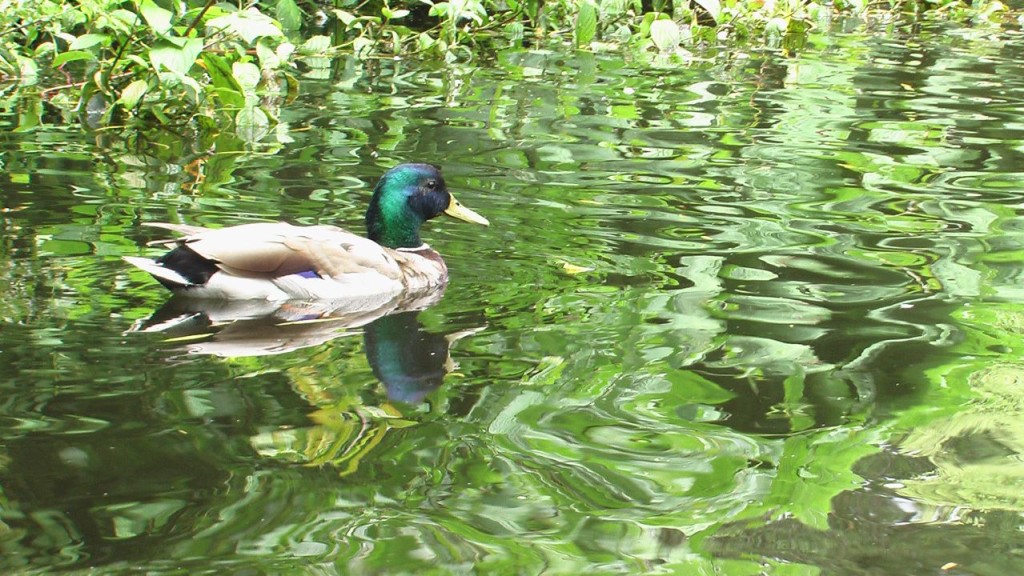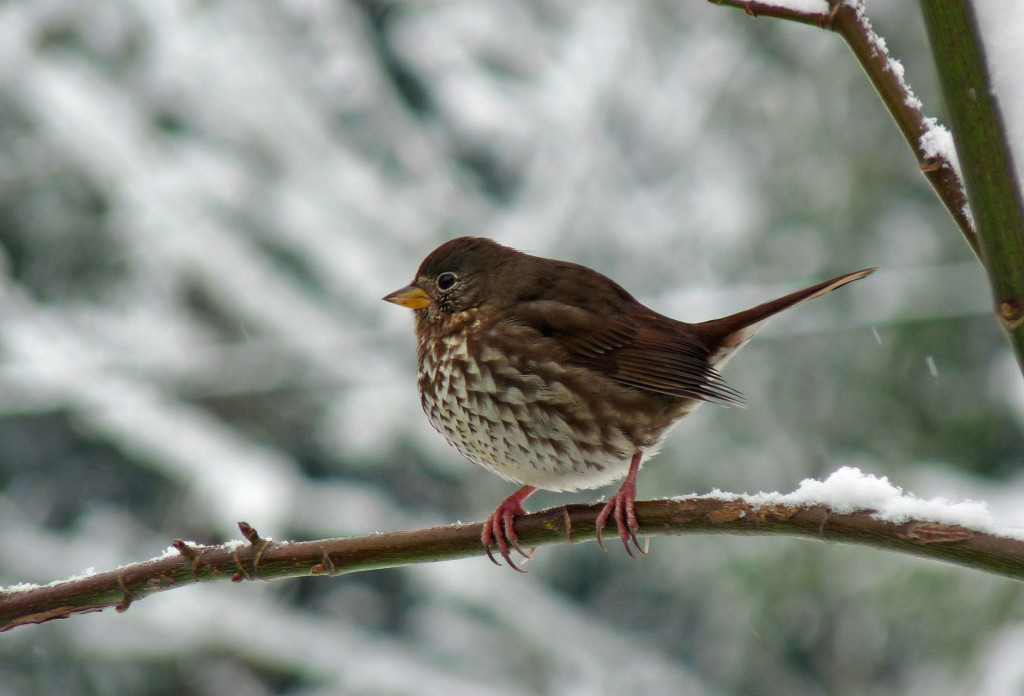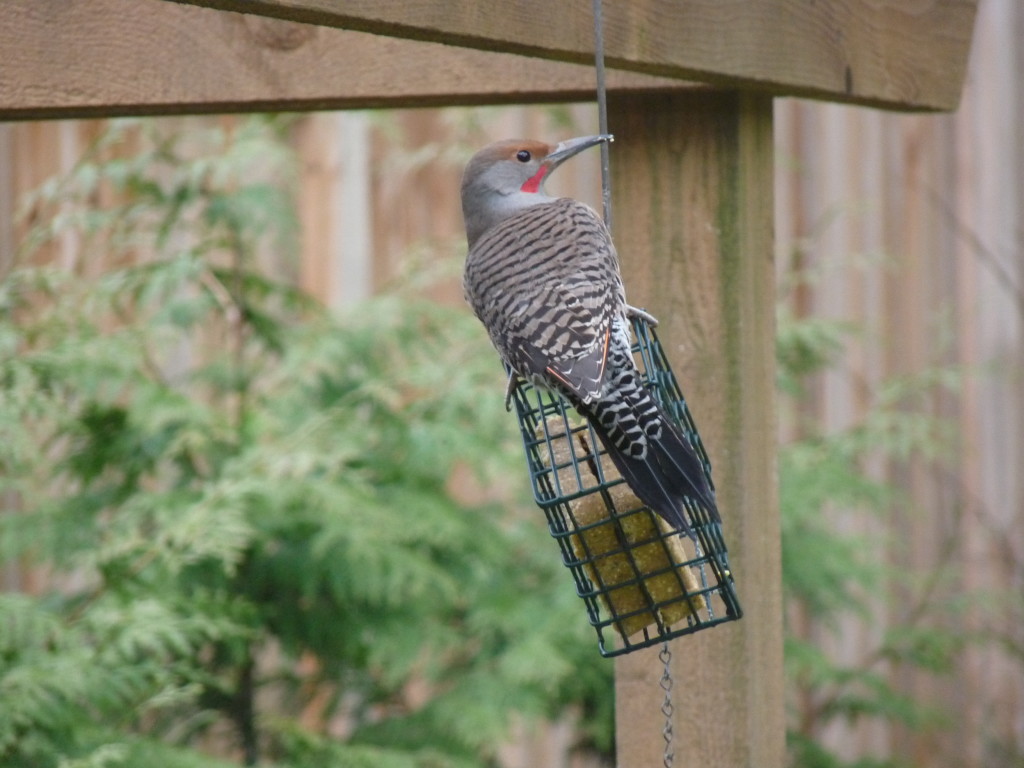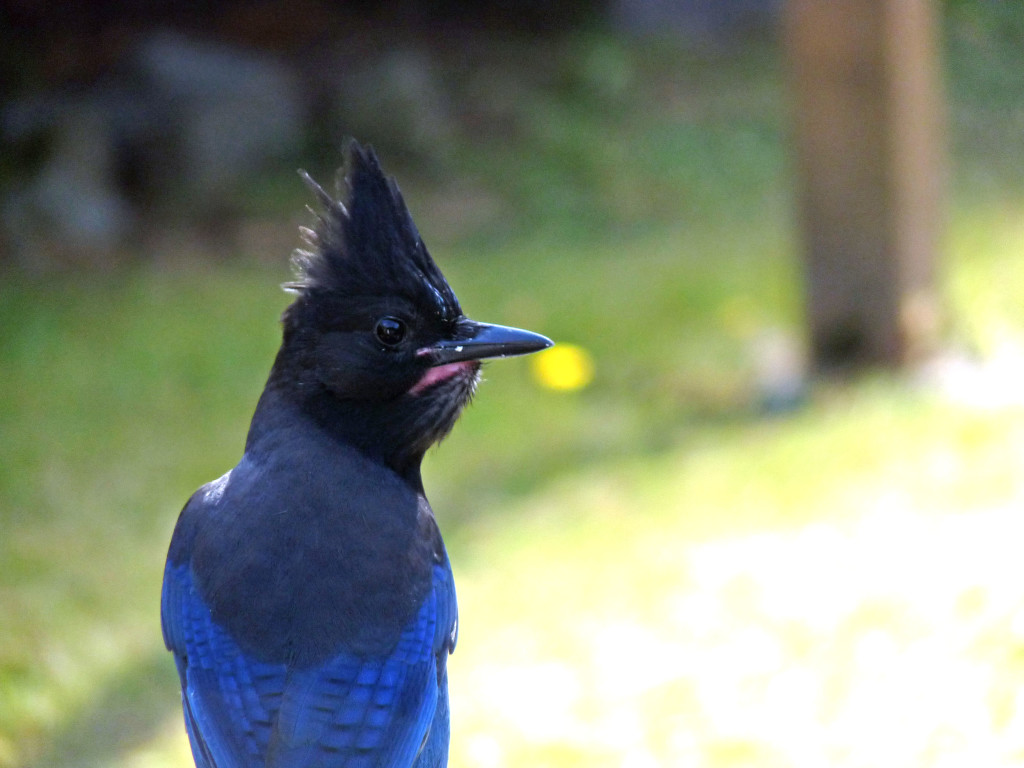Last month 28 Gabriolans participated in the 115th Audobon Christmas Bird Count. Here’s a sampling of the bird species that were counted on the island. Many thanks to the Gabriola Island photographers – Doug Green, Garry Davey, Eileen Kaarsmaker, and Iain Lawrence – who so generously shared their photos with me.
Again this year, the Chestnut-backed Chickadee was our most numerous bird at 439. This chickadee that inhabits Vancouver Island and the gulf islands off the coast of BC is a cousin of the Black-capped Chickadee, the Bird of the Year for 2015 in Vancouver BC, my hometown. If you’d like to hand-feed a wild bird, a chickadee is usually willing. Just be sure to take down your feeders first.
Red-breasted sapsuckers are an important keystone species. Rufous Hummingbirds drink sap from the shallow holes they dig in the outer bark of trees like this old cedar in our front yard, Red-breasted Nuthatches smear sap from the wells around their own nest cavities, and chickadees, nuthatches, and wrens use their nest cavities when the Sapsucker is finished with them.
In spite of the fact that only 3 Barred Owls were counted on Dec 28, anyone who lives here knows there are lots of these guys around. Their raucous mating calls can be heard far and wide in the spring. And they’re not shy about hanging around garage roofs or fence posts during the day.
The Spotted Towhee, with its signature red eye, is lovely to look at. Too bad about that incessant squawk! The three pairs that live in our yard right now have taken to grabbing peanuts from right under the jays’ noses. On Dec 28, 126 were counted.
Although no Trumpeter Swans were seen off the shores of Gabriola during the count, 106 were counted across the strait in Nanaimo. The swans above were visiting Coats Marsh on Gabriola in the spring.
The Mallard is a ‘dabbling’ duck: it either eats from the surface of the water or tips its tail up to dabble just under the surface for aquatic leaves, stems, seeds, and invertebrates. (Happily, it also eats lots of mosquito larvae.) The Mallard also differs from most other ducks in its vociferousness. While many ducks are relatively quiet – except when mating or protecting the nest – the female Mallard (less colourful than the male in the photo) is vocal year-round. When you think of quacking ducks, you’re probably thinking of female Mallards. The male’s vocalizations are deeper and quieter. 93 made the count.
It’s rumoured that a Pileated Woodpecker was the inspiration for Woody the Woodpecker. But this guy’s no cartoon character. He makes almost perfectly rectangular holes in trees with his long chisel-like bill to get at carpenter ants and other insects.
The Fox Sparrow that frequents Gabriola is the “Sooty’ variety and has an almost-chocolate brown back and dark crown. Its breast is streaked with chevron-shaped spots that coalesce into one large brown spot in the centre of the chest. New birders often have trouble distinguishing between the Song Sparrow and Fox Sparrow. One reliable way to differentiate the two is to look for the Fox’s yellow mandible, or lower bill. For this, of course, you may need a good pair of binoculars.
The Belted Kingfisher is one of the few species where the female is more colourful than the male. This female may have just received this fish from a wooing male. Gifts of fish are the male kingfisher’s version of taking a girlfriend out to dinner. If you ever visit Gabriola in spring, check out their nests along the sandstone cliff as the ferry pulls into dock!
There are several flocks of California Quail on the island but only 3 individuals showed up for the count. That topknot looks like one feather but is really a cluster of six.
It’s true the Black Oystercatcher wears mostly black, but that bright orange eye and long orange bill and those rosey-pink legs are striking accessories!
In addition to suet, Northern Flickers eat a lot of ants; one scientist apparently found 2000 in a flicker’s stomach. They also use ants in preening. During this process, called ‘anting’, flickers rub the insects on their feathers, and the ants secrete liquids containing formic acid and other chemicals that help protect them from parasites. Two pairs regularly dine in our yard. Counted – 28.
The elegant Great Blue Heron lives around fresh water and salt water. They may also visit backyard fish ponds, as our neighbour recently found out. But the Cornell Lab’s All About Birds site has a solution: lay a piece of pipe in the pond for the fish to hide in.
During the count, 103 Canada Geese were seen on Gabriola. But I took this photo of a Canada Goose at the Reifel Bird Sanctuary in Delta a few years ago. He’s probably sleeping but I like to pretend he’s doing yoga.
The lovely-to-look-at Varied Thrush has a most unusual song. It’s been described as “A slow whistled mysterious-sounding caroling melody followed by fast prolonged warbling, first high, then low, and fading at the end.” (Smithsonian Handbooks’ Birds of North America: Western Region, by Fred Alsop III) and as a “fairly long, ethereal, trilled whistle, repeated at different pitches after long pauses” (Birds of Southwestern British Columbia by Richard Cannings, Tom Aversa, and Hal Opperman). John Neville and Mel Coulson (Beginner’s Guide to BC Bird Song) refer to the bird as a “tone deaf thrush” and to its song as “plaintive and most unmusical” and “sounding something like a referee’s whistle.” I guess it’s all in the ears of the listener.
The stunning Barrow’s Goldeneye (note the golden eye!) is a true ‘diving duck’. It will dive down as far as five metres to grab insects, mollusks, crustaceans, and fish eggs. 22 showed up on count day.
The Hairy Woodpecker and the Downy Woodpecker, two of the most common woodpeckers on the island, look remarkably alike. You can tell this one’s a Hairy because its bill is almost as long as the depth of its head. The Downy has a shorter, stubbier bill.
“Greybeard” is one of the nine Steller’s Jays that call our backyard home. Although only 35 were counted during the Christmas Bird Count, I’m sure there are lots more on the island! You may have seen the little experiment we did with them in the summer of 2013. If not, you can check it out here: https://birdcanada.com/just-how-smart-are-those-jays/
The infamous Gabriola feral turkeys, which didn’t get counted this year, continue to entertain me. I especially enjoy watching the Bertha Road flock of 10 roosting on the power lines at night. How they manage to balance up there remains a mystery!






















Sounds like you had a great count. And the weather looked good, too! And how lucky you were to see an owl (not to mention all of the other great birds).